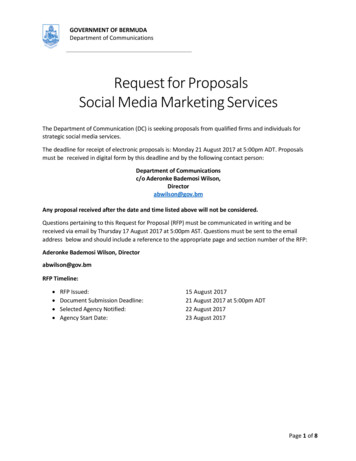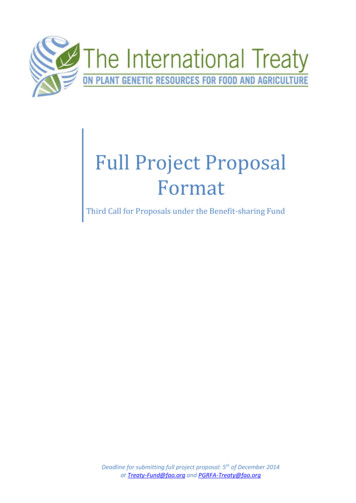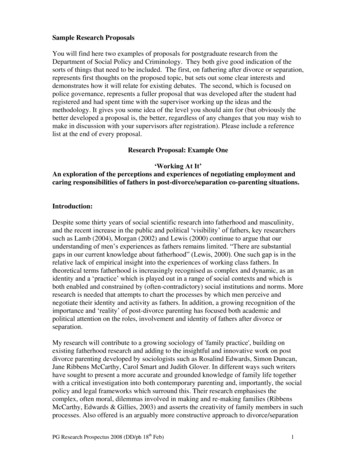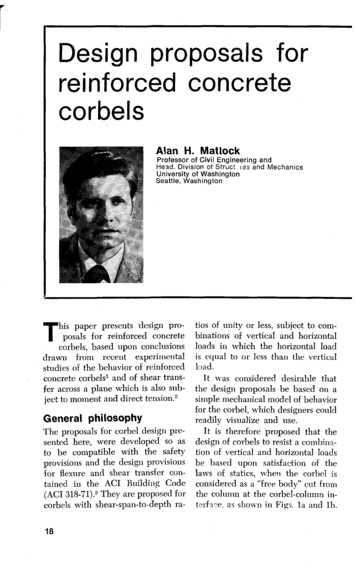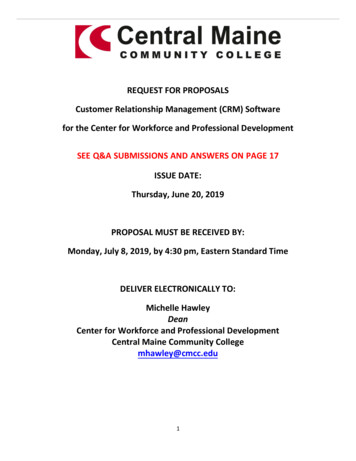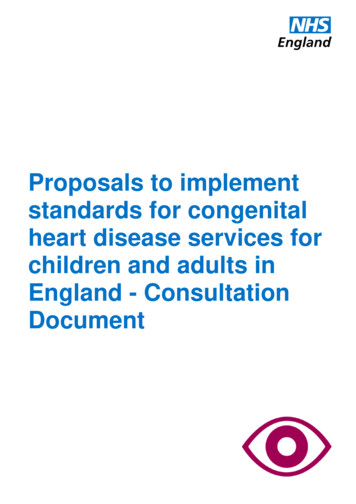
Transcription
Proposals to implementstandards for congenitalheart disease services forchildren and adults inEngland - ConsultationDocument
OFFICIALNHS England INFORMATION READER BOXDirectorateMedicalNursingFinanceCommissioning OperationsTrans. & Corp. Ops.Publications Gateway Reference:Patients and InformationCommissioning Strategy06374Document PurposeConsultationsDocument NameProposals to implement standards for congenital heart disease forchildren and adults in England - Consultation DocumentAuthorNHS EnglandPublication Date09 February 2017Target AudienceCCG Clinical Leaders, CCG Accountable Officers, Foundation TrustCEs , Medical Directors, Directors of Nursing, NHS England RegionalDirectors, NHS England Directors of Commissioning Operations, NHSTrust CEs, Public; Patients; Families; Carers; Patient Grouprepresentatives; charitiesAdditional CirculationListAll NHS England Employees, Directors of HR, Directors of Finance,Communications LeadsDescriptionNHS England is consulting on its proposals to implement nationalstandards for congenital heart disease services for children and adults.This document sets out the background and context for our proposals;explains the proposals in more detail, including their potential impact, ifimplemented; and how you can get involved in consultation.Cross ReferenceSuperseded Docs(if applicable)Action RequiredTiming / Deadlines(if applicable)Contact Details forfurther informationN/AN/AN/AConsultation runs from 9 February to 5 June 2017Michael WilsonProgramme Director Congenital Heart Disease ProgrammeNHS EnglandSkipton House80 London RoadSE1 6LHwww.engage.england.nhs.ukDocument StatusThis is a controlled document. Whilst this document may be printed, the electronic version posted onthe intranet is the controlled copy. Any printed copies of this document are not controlled. As acontrolled document, this document should not be saved onto local or network drives but shouldalways be accessed from the intranet.Page 2
OFFICIALProposals to implement standards for congenital heartdisease for children and adults in EnglandConsultation DocumentFirst published: 9 February 2017Prepared by: Specialised Commissioning, NHS EnglandClassification: OFFICIALPage 3
OFFICIALContentsContents . 4Foreword . 6Background and context . 8The case for change . 101.1 Ending uncertainty . 121.2 Ending occasional practice . 131.3 Resilient, sustainable services . 14Proposals for consultation . 15How our proposals were developed . 221.4 Meeting the standards . 22Potential impact of implementing our proposals . 25Pre-consultation engagement and involvement . 261.5 Engagement activity . 26Consultation. 271.6 Why are we consulting? . 271.7 How can I make my views known? . 281.7.1 How to get involved. 281.7.2 How to let us know your views . 291.8 What happens next?. 29Appendix A: Consultation Questions . 31Appendix B: Summary of Impact Assessment . 401.9 Impact on patients . 401.10Impact on CHD services. 421.11Impact on other services . 431.11.1Impact on other services: Paediatric Intensive Care . 431.11.2Impact on other services: Extracorporeal Membrane Oxygenation(ECMO) 441.11.3Impact on other services: Specialist paediatric respiratory services . 451.12Workforce Impact . 461.12.1Provider organisations where level 1 services would be provided underthe proposals: workforce impact . 461.12.2Provider organisations where level 1 services would no longer beprovided under the proposals: workforce impact . 461.13Financial Impact . 481.13.1Provider organisations where level 1 services would be provided underthe proposals: finance impact . 481.13.2Provider organisations where level 1 services would no longer beprovided under the proposals: finance impact . 49Equalities and Health Inequalities. 511.141.151.16Age . 51Disability . 52Gender reassignment . 52Page 4
OFFICIAL1.17Marriage and civil partnership . 531.18Pregnancy and maternity . 531.19Race . 531.20Religion or belief . 541.21Sex or gender. 541.22Sexual orientation . 541.23Asylum seekers and/or refugees . 541.24Carers . 551.25Those living with mental health issues . 551.26Other groups . 55Glossary . 57Page 5
OFFICIALForewordIn July 2016, NHS England published a set of proposals regarding the futurecommissioning of congenital heart disease (CHD) services for children and adults.They describe the actions which we, as commissioners, propose to take in order toensure a consistent standard of care for CHD patients across the country, for nowand for the future.We propose to do this by implementing national service standards at every hospitalthat provides CHD services. The effect of our proposals, if implemented, will be thatsome hospitals will carry out more CHD surgery and catheter procedures, whileothers, which do not meet the relevant standards, will stop doing this work.The standards describe services of the highest possible quality. They weredeveloped by patients, and their families and carers, by surgeons and other specialistdoctors and nurses, and were formally agreed by the NHS England Board in 2015.We acknowledged then that implementation of them would be a challenge for somehospitals. We also recognised that it might subsequently prove necessary to maketough choices when considering how to put them into practice.The guiding principle for our work has always been ‘patients come first’. Thatprinciple remains at the forefront of our thinking today. It was patients, and theirfamilies/carers and representatives, as well as clinicians in the field, who told us –consistently – that the standards were only worth something if they were actuallyacted upon and met.Now is the time for decisive action. We have an opportunity to future-proof CHDservices, by ensuring that the standards are met. This will enable services to bettercope with an increasing number of complex cases and make best use of advances intechnology. We must not squander this opportunity. Equally, however, we mustensure that our commissioning decisions are informed by the views of patients andtheir families and carers, by clinicians and other hospital staff, and by otherstakeholders.We know that if our proposals are implemented, they will have an impact, not just onpatients, but on this small number of hospitals, and some of the other services whichthey deliver, as well as on the staff working in them. We know that some of you areconcerned about potentially longer journey times; having to travel greater distancesfor surgery; the availability of support and accommodation while away from home,and what might happen if there is an emergency. Thankfully, true emergencies incongenital heart disease are incredibly rare, but we recognise your concerns, andhave tried to address them later in this document.This is why we want to hear from you, during this public consultation, so that we canbetter understand how any changes might affect you and how we might supportpatients, hospitals and staff, during any future change. Before reading the rest of thisconsultation document, there are some important points which you might want toconsider:Page 6
OFFICIAL No decisions about the future commissioning of CHD services have beentaken. The proposals published in July were just that – proposals. If you canthink of alternative ways in which the standards can be met, then we want tohear from you;This is not about saving money. You will already know that money is tight inthe NHS, and the NHS has to live within its means. While implementing mostof the standards will cost little, or nothing, we expect the overall amount ofmoney spent on CHD care to increase in the future, driven by the growingnumber of patients living with this condition;These proposals are not about closing CHD units. We do not have a fixednumber of hospitals providing CHD services in mind. This is about ensuringthat every hospital providing a CHD service meets the standards. We have noview about the final number of hospitals which are able to do that;This is not about a short-term fix. We are focusing on the long-term resilienceand sustainability of CHD services for generations to come.Finally, we would like to acknowledge the significant time and effort whichpatients, parents, families, carers, and NHS staff have put into the various piecesof work which have been carried out during the past 16 years, all aimed atimproving congenital heart disease services in England. We have all been at thisa long time, and we recognise the cloud of uncertainty which hangs over theseservices as a result.We need to put an end to this uncertainty, for everybody’s sake. So, as you readthis document, we hope that you will keep the future long-term stability of theseimportant services in mind, and help us to reach a clear, and long-term,resolution, in the best interests of patients.Will HuxterSenior Responsible Officer forCHD Commissioning andImplementation Programme &Regional Director forSpecialised CommissioningProfessor Huon GrayNational Clinical Director for HeartDisease, NHS England & ConsultantCardiologist, University Hospital ofSouthamptonPage 7
OFFICIALBackground and context“Sixteen years is a long time to wait. We have lost key consultant staff to postsabroad during that time, as they were not convinced that we were ever going tograsp this nettle. This is our last opportunity to make change happen. If we don’tgrasp this opportunity now, we have to accept that ‘adequate’ is good enough”.Professor Huon GrayConsultant Cardiologist, University Hospital Southampton NHS FoundationTrust, and National Clinical Director for Heart Disease, NHS England1. Congenital heart disease (CHD) refers to a heart condition or defect thatdevelops in the womb, before a baby is born. There are many different formsof CHD, some more minor than others. Some people with CHD do not requireany form of surgery or interventional procedure in the treatment of theircondition; others require surgery before, or immediately after, birth. Thanks toadvances in early diagnosis and medical advances, most babies born withCHD grow up to be adults, living full and active lives. CHD is common. It isestimated that between 5 and 9 in every 1000 babies born in the UK is bornwith CHD – this is around 5,500 to 6,300 babies each year. These figures willcontinue to increase if birth rates continue to rise, which leads to an increasein the number of operations and interventional procedures carried out on CHDpatients each year.2. Many congenital heart disease services work together in networks, so thatneighbouring hospitals have good systems for referring patients, and forpassing information back and forth. Networks help local services to workclosely with specialist centres, to ensure that patients receive the care theyneed in a setting with the right skills and facilities, as close to home aspossible.3. Services are based around a three-tiered model of care with specialistsurgical centres (Level 1) managing the most highly complex diagnostics andcare, including all surgery and interventional cardiology. At the next level arespecialist cardiology centres (Level 2), which provide the same level ofspecialist medical care as Level 1, but do not provide surgery or interventionalcardiology (except for one, specific minor procedure – atrial septal defect(ASD) closures, more commonly known as ‘hole in the heart’ – at selectedhospitals treating adults. These Level 2 hospitals focus on diagnosis, plusongoing care and management of CHD. At Level 3 will be local cardiologyservices, which are services in local hospitals run by generalpaediatricians/cardiologists with a special interest in CHD. They will provideinitial diagnosis and ongoing monitoring and care, including joint outpatientclinics with specialists from Level 1 and 2 hospitals. These services arecommissioned by local Clinical Commissioning Groups (CCGs), and not byPage 8
OFFICIALNHS England. We are working with CCG commissioners to address the needfor a more integrated approach to care across the three tiers.4. Anybody who is familiar with the history of these services will know thatpublication of NHS England’s proposals in the summer of 2016 representedthe latest milestone in a very long journey, stretching back 16 years, to thepublication of the report of a public inquiry into concerns about the care ofchildren receiving complex cardiac surgery at Bristol Royal Infirmary. Thiswas followed by the Safe and Sustainable review, launched by theDepartment of Health, in 2008. This review set out recommendations for aCHD service based on networks; with clinical standards for all hospitalsdesignated to provide heart surgery for children, and a reduction in thenumber of NHS hospitals in England providing that heart surgery. Ultimately,these recommendations were not implemented, following intervention with theSecretary of State.5. We know, from talking to stakeholders, that the failure to implement therecommendations of previous reviews has created uncertainty for patientsand staff, and concerns raised during these, and other enquiries, haveremained. However, despite the fact that previous reviews have not resultedin a coordinated programme of change, progress has been made. Outcomesfor CHD surgery and interventional procedures across England are good, andcompare well with other countries. We also know, from talking to patients andtheir families and carers in particular, that the quality of CHD care delivered inhospitals is very good. We have heard many, many positive stories aboutindividual patient experiences, and recognise that each of those personaltestimonies carries real weight, and shapes how people feel about the NHSservice which has cared for, or saved the life of, their loved ones.6. When NHS England took on responsibility for the commissioning of CHDservices in 2013, we were aware of the impact that previous reviews had had,as described above, and were told by patients, families, doctors and nursesalike, that the best way to deal with these issues was through thedevelopment of service standards, setting out how a good CHD serviceshould be set up, organised and run.7. We worked with the different groups of stakeholders for more than two years,as part of the New Congenital Heart Disease Review, to create a set ofquality and service standards that covered the entire patient pathway, fromdiagnosis, through treatment, and on into care at home and end of life care, tomake sure that every child, young person and adult with CHD, in every part ofthe country, would receive the same high standard of treatment.8. Surgeons told us how many operations should be done by each surgeonevery year in order to maintain the surgeons’ skills. Similarly, specialistdoctors and nurses told us what medical care should be available by thebedside of a patient in a critical condition. Patient representatives led the workin developing the standards covering communication, facilities andbereavement. Additionally, for the first time ever, the transition from children’sPage 9
OFFICIALservices to adult services was included in the standards, to ensure that careis truly joined up.9. The standards have never been considered as an end in themselves. Theywere developed in the full expectation that their implementation at everyhospital in the country providing CHD services would be the means by whichour work would be delivered, i.e: securing best possible outcomes for all patients – not just reducing thenumber of deaths, but reducing disability caused by disease, andimproving people’s quality of life;tackling variation, so that services are consistent in meeting standards,each of them offering 24/7 care, seven days a week, as part of anationally resilient service;improving patient experience, including provision of better informationfor patients, plus more consideration of access and support for familieswhen they are away from home.10. This review has been underpinned by principles of openness andtransparency, and a need to engage as widely as possible, bringing patients,families, carers, patient representatives, and clinicians together, in the jointpursuit of an effective and equitable solution, in the interests of patients now,and in the future. Consensus across all groups was achieved on the contentof the standards, and it became clear that NHS England, as the sole nationalcommissioner of CHD services had a unique opportunity to drive serviceimprovement, and reduce variation in access and quality, by implementing aset of nationally-agreed standards, governing a truly national service.The case for change11. The standards describe how to deliver CHD services of the very highestquality. We believe that implementation of these standards is the only way toensure that patients are able to access care delivered to the same highstandards, regardless of where they are treated. There is currently somevariation as to where individual hospitals lie in meeting the standards, so caremay vary, depending on where in England you access services.12. We know, from talking to patients and their families/carers, that some peopleconsider the care that they and their loved ones have experienced at ahospital to be the best there is. We do not wish to detract from that verypersonal experience, but it is not the same for everyone, and that simply isnot fair.13. Once all hospitals are meeting the standards, we can ensure that patientswith CHD will be receiving the same levels of high quality care. For patients,and their families and carers, this means: higher levels of support from specialist nurses and psychologists;Page 10
OFFICIAL improved communication and information, so that newly diagnosedpatients have a better understanding of their condition; the careprovided; treatment options; and how to take part in decisions abouttheir own care;better managed transition from children’s to adult services;improved palliative and end of life care, with specific standards focusedon support for bereaved families and carers.The above were all aspects of care which patients and patient groups told uswere important, and are examples of the highest possible quality care, whichwe think should be available to all CHD patients, regardless of which hospitalthey attend.14. For clinicians, and their teams, the broader benefits of meeting the standardswill include: hospitals caring for people with CHD have the right staffing and skillsmix, with no fewer than minimum staffing and activity levels, whichsupport the maintenance of skills and expertise;improved resilience and mutual support provided by a networkedmodel of care;enhanced opportunities for developing sub-specialisation;enhanced training and mentorship; sharing learning and skills; qualityassurance and audit;elimination of isolated and occasional practice – this is when smallvolumes of surgery and interventional cardiology are undertaken inhospitals that do not offer specialist expertise in this field.15. What we have described here are tangible benefits, things that will reallymake a difference to the care of patients with CHD, and to the teams caringfor them. We believe that every patient receiving care for CHD should expectthese highest possible standards of care, regardless of where they receivetheir treatment.Page 11
OFFICIAL“From my perspective there are three main clinical advantages for having highvolume congenital cardiac surgical centres. Firstly, as an individual surgeon themore I do the better I become. There's lots of evidence for this in other surgicalspecialties, in particular showing that high volume centres reduce the number ofpost-operative complications and improving long-term quality of life. This alsoworks for the whole team providing the care: the more the team does, the betterthey become, and this gives a huge opportunity for people to learn from eachother in a large multidisciplinary setting.And finally, higher surgical volumes enable specialisation in areas such asneonatal, congenital and device treatments. Importantly, these are all importantfor the next generation of surgeons coming up through the system - they will beless experienced when they become consultants than in the past - and they willneed to fit into a large team to nurture them into becoming the surgeons of thefuture.”Mr Martin Kostolony - Head of Clinical Service - Cardiothoracic Surgery,Great Ormond Street Hospital for Children NHS Foundation Trust16. Apart from the benefits achieved by meeting the standards themselves, thereare some specific additional benefits associated with implementation of thestandards:1.1 Ending uncertainty17. The long history of repeated reviews of CHD services has created uncertaintywithin the specialty, damaging relationships between hospitals; harmingrecruitment and retention of specialist staff; and reducing the resilience ofservices. Continued uncertainty affects recruitment and retention ofcongenital heart disease surgeons, a group in short supply and subject tointernational demand.18. The 2014 report on CHD services at Leeds Teaching Hospitals NHS Trust 1recommended that NHS England should act to dispel the “almost morbidsense of spectatorship and foreboding that hangs over these services”. Clearresolution is now needed to bring the stability the service needs to /uploads/2014/./leeds-review.pdfPage 12
OFFICIAL1.2 Ending occasional practiceWe have been calling for standards for adult congenital heart disease for manyyears and it is excellent that this has finally been achieved. Never before havethe services for adults been designated and therefore occasional practice hashappened. The introduction of these standards has already mainly eliminatedthat occasional practice and I am confident it will be a thing of the past, providinga much safer level of care and that is what these standards are all about.Michael Cumper, Vice President, Somerville Foundation19. Occasional and isolated practice (small volumes of surgery and interventionalcardiology undertaken in hospitals without sufficient specialist expertise) hasbeen a big concern, particularly for charities representing adults with CHD.20. We asked every non-specialist hospital, where the data showed CHDprocedures had taken place, to either cease occasional practice or take stepsto meet the requirements of the standards, including minimum volumerequirements. Most of these hospitals confirmed that the apparent occasionalpractice was due to coding errors. In other cases the practice had alreadystopped or steps were being taken to move this activity to an appropriatespecialist Level 1 or Level 2 hospital. Some hospitals confirmed that theywished to be considered as specialist medical centres (Level 2), so weassessed them against the relevant standards21. Occasional practice has largely been addressed through this process. Wherethe issue has not yet been resolved, it will be followed up by NHS England’sregional teams.Page 13
OFFICIAL1.3 Resilient, sustainable services“We know that many people are very nervous about how the standards aremoved forward, we must acknowledge those fears and support patients andfamilies affected by any change but if we do not start to implement the newstandards soon we will start to see a deterioration in the service.We know that there are a growing number of children with highly complexconditions travelling through care. It is really important to make sure that thereis a really strong service for them from the beginning of their lives, through theirchildhood and into adult services. They deserve nothing less.Suzie Hutchinson, Chief Executive and Service Lead, Little Hearts Matter22. Larger hospitals with bigger teams, more effectively networked with otherhospitals, will be more resilient, providing an assurance of full 24-hour,seven- day care and a greater ability to cope with challenging events, forexample the loss of a surgeon. We know, from talking to clinicians, that theyfeel best able to carry out their work when they are part of a team. Surgeonsneed the support of fellow surgeons, to provide cover for annual leave, and tostep in when colleagues fall sick. They also need the support of an expertteam around them. It is this kind of set-up that builds resilience in a service,and ensures that patients get access to the best possible care when theyneed it. The only way we can build this resilience is if we implement thestandards.23. The standards are – rightly – challenging, and it was acknowledged by theNHS England Board, when they were adopted, that it would be difficult for allhospitals to meet them, unless changes were made to the way in which thosehospitals work. This is why the timeline for meeting some of the standardsdiffers, as it was recognised that meeting some standards would take longerthan others. For instance, the co-location of children’s CHD services withother children’s services might require physical changes to a hospital’sstructure or layout.24. Our proposals are described in detail on page 15. If they are implemented, infuture, CHD services will only be provided by hospitals which already meetthe standards required, or are likely to meet the standards within requiredtimeframes as a result of the improvement plans they are putting in place.Page 14
OFFICIAL“We fully support these standards. NHS England must ensure that the standardsare applied for the benefit of patients, by ensuring that expertise is concentratedwhere it is most appropriate. The proposals put forward by NHS England in July2016 should improve patient outcomes and help address variations in carecurrently provided”.Royal College of Surgeons and the Society for Cardiothoracic Surgery(SCTS)Proposals for consultation25. At the heart of our proposals is our aim that every patient should be confidentthat their care is being delivered by a hospital that is able to meet the requiredstandards. In order to achieve this, we propose that in future, NHS Englandwill only commission CHD services from hospitals that are able to meet thestandards within the required timeframes.26. Three specific standards are relevant to our proposals:-Surgeon working requirements – the number of surgeons at each hospital,and the number of operations they each perform.o The standards require that, for 2016, surgeons work in teams with aminimum of three surgeons, and in teams of at least four surgeons
congenital heart disease are incredibly rare, but we recognise your concerns, and have tried to address them later in this document. This is why we want to hear from you, during this public consultation, so that we can . We need to put an end to this uncertainty, for everybody's sake. So, as you read this document, we hope that you will .



